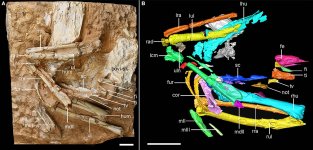Fred Ruhe
Well-known member

Zhiheng Li, Thomas A. Stidham, Tao Deng & Zhonghe Zhou. 2020
Evidence of late Miocene peri-Tibetan aridification from the oldest Asian species of sandgrouse (Aves: Pteroclidae)
Frontiers in Ecology and Evolution. 8: Article 59. doi:10.3389/fevo.2020.00059
Abstract: https://www.frontiersin.org/articles/10.3389/fevo.2020.00059/full
The partial skeleton of a new extinct taxon, Linxiavis inaquosus, from the Liushu Formation (6–9 Ma) at the edge of the Tibetan Plateau in Gansu Province, China is the most substantial known fossil record of sandgrouse (Pteroclidae). While adding to the rapidly growing known Liushu avian fauna of vultures, falcons, pheasants, and ostrich, this new fossil is likely the oldest record of crown Pteroclidae (as a potential molecular clock calibration point), the oldest record of the group in Asia (from a probable African origin), and derives from a significant temporal gap in their Neogene history. The fossil specimen includes articulated and associated elements of the wings, shoulder girdle, vertebrae, and hind limb, exhibiting apomorphies of Columbiformes and Pteroclidae such as a notarium, and a short coracoid shaft. As part of the diverse Hipparion fauna, Linxiavis inaquosus reinforces the interpretation of the late Miocene Linxia Basin habitat as an arid savannah, associated with the uplift of the Tibetan Plateau. The holotype suggests that the arid high elevation Tibetan area habitats may have been continuously occupied since the late Miocene by sandgrouse carrying water in their modified breast feathers to their young.
Enjoy Fred
Evidence of late Miocene peri-Tibetan aridification from the oldest Asian species of sandgrouse (Aves: Pteroclidae)
Frontiers in Ecology and Evolution. 8: Article 59. doi:10.3389/fevo.2020.00059
Abstract: https://www.frontiersin.org/articles/10.3389/fevo.2020.00059/full
The partial skeleton of a new extinct taxon, Linxiavis inaquosus, from the Liushu Formation (6–9 Ma) at the edge of the Tibetan Plateau in Gansu Province, China is the most substantial known fossil record of sandgrouse (Pteroclidae). While adding to the rapidly growing known Liushu avian fauna of vultures, falcons, pheasants, and ostrich, this new fossil is likely the oldest record of crown Pteroclidae (as a potential molecular clock calibration point), the oldest record of the group in Asia (from a probable African origin), and derives from a significant temporal gap in their Neogene history. The fossil specimen includes articulated and associated elements of the wings, shoulder girdle, vertebrae, and hind limb, exhibiting apomorphies of Columbiformes and Pteroclidae such as a notarium, and a short coracoid shaft. As part of the diverse Hipparion fauna, Linxiavis inaquosus reinforces the interpretation of the late Miocene Linxia Basin habitat as an arid savannah, associated with the uplift of the Tibetan Plateau. The holotype suggests that the arid high elevation Tibetan area habitats may have been continuously occupied since the late Miocene by sandgrouse carrying water in their modified breast feathers to their young.
Enjoy Fred




